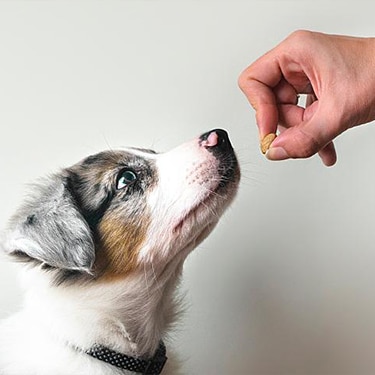
-
Find the right food for your petTake this quiz to see which food may be the best for your furry friend.Find the right food for your petTake this quiz to see which food may be the best for your furry friend.Featured products
 Hill's Science Diet Adult Chicken & Beef Entrée Dog Food
Hill's Science Diet Adult Chicken & Beef Entrée Dog FoodChicken & Beef Entrée in a delicious loaf with complete & balanced nutrition to help keep adult dogs active and healthy
Shop Now Adult Large Breed Chicken & Barley Recipe Dog Food
Adult Large Breed Chicken & Barley Recipe Dog FoodSupports healthy joints, lean muscle, and beautiful coat for large breed dogs
Shop Now Adult Chicken & Barley Recipe Dog Food
Adult Chicken & Barley Recipe Dog FoodSupports lean muscle and beautiful coat for adult dogs
Shop NowFeatured products Adult Tender No Corn, Wheat, Soy Chicken & Vegetables Stew Cat FoodShop Now
Adult Tender No Corn, Wheat, Soy Chicken & Vegetables Stew Cat FoodShop Now Senior Vitality Adult 7+ Tuna & Vegetables Stew
Senior Vitality Adult 7+ Tuna & Vegetables StewImproves Everyday Ability to Get Up & Go
Shop Now Adult Turkey & Liver Entrée Cat Food
Adult Turkey & Liver Entrée Cat FoodPrecisely balanced nutrition with the delicious taste of minced turkey & liver to help fuel the energy needs of cats during the prime of their life
Shop Now -
Dog
- Dog Tips & Articles
-
Health Category
- Weight
- Food & Environmental Sensitivities
- Urinary
- Digestive
- Joint
- Kidney
-
Life Stage
- Puppy Nutrition
- Adult Nutrition
- Senior Nutrition
Cat- Cat Tips & Articles
-
Health Category
- Weight
- Skin & Food Sensitivities
- Urinary
- Digestive
- Kidney
-
Life Stage
- Kitten Nutrition
- Adult Nutrition
Featured articles The Science Behind Our Love for Pets
The Science Behind Our Love for PetsLearn the scientific reasons why we have such strong connections with our pets, and what science says about the love between humans and our furry friends.
Read More How to Properly Mix Wet & Dry Pet Foods
How to Properly Mix Wet & Dry Pet FoodsAn Orange cat eating from a bowl filled with mixed food
Read More What Is Littermate Syndrome? Pet Adoption Guide
What Is Littermate Syndrome? Pet Adoption GuideLearn more about littermate syndrome in dogs and cats and how to successfully navigate adoption and early socialization processes.
Read More -


 Dogs are classified as members of the family Canidae and the order Carnivora, but this does not necessarily translate to behavior, anatomy or feeding preferences.
Dogs are classified as members of the family Canidae and the order Carnivora, but this does not necessarily translate to behavior, anatomy or feeding preferences.
Judge for yourself
Some animals may look like carnivores or act like carnivores. But, are they really true carnivores? You be the judge.
- Wolves attack plant-eating animals, but one of the first parts they consume is the stomach contents and the viscera of those animals.1
- Coyotes eat a variety of foodstuffs including small mammals, amphibians, birds, fruits and herbivore feces.
- Panda bears are also members of the order Carnivora, but they are herbivores who primarily consume bamboo leaves.
The acid test
Key points
- The term "opportunivore" may best describe the dog's natural desire to eat whatever is available — plants as well as animals.
Strict or true carnivores, such as cats, have a higher nutritional requirement for taurine (an amino acid), arachidonic acid (a fatty acid), and certain vitamins (niacin, pyridoxine, vitamin A), which are readily available in animal protein and fat sources.
Omnivores, such as dogs and people, don't have higher requirements for taurine and certain vitamins and can create their own arachidonic acid from vegetable oils.


Tasty Tips
Omnivore qualities
There are other nutritional, behavioral and physical factors that separate the omnivore and carnivore worlds:
- Dogs have teeth (molars) with relatively flat surfaces designed to grind up bones as well as fibrous plant material.
- Dogs can digest almost 100% of the carbohydrates they consume.2
- Dogs have a small intestine that occupies about 23 percent of the total gastrointestinal volume, which is consistent with other omnivores; the small intestine of cats occupies only 15 percent.3,4
- Dogs can create vitamin A from betacarotene found in plants.
Confusion in their conclusion
Some folks have come to the erroneous conclusion that dogs must be carnivores because they fall under the order Carnivora. A close look at the anatomy, behavior and feeding preferences of dogs shows that they are actually omnivorous — able to eat and remain healthy with both animal and plant foodstuffs.
1 Lewis L, Morris M, Hand M. Small Animal Clinical Nutrition, Ed. 4. Topeka, KS, Mark Morris Institute, 2000;294-303,216-219.
2 Walker J, Harmon D, Gross K, Collings G. Evaluation of nutrient utilization in the canine using the ileal cannulation technique. J Nutr. 1994; 124:2672S-2676S.
3 Morris JG, Rogers QR. Comparative aspects of nutrition and metabolism of dogs and cats, in: Nutrition of the dog and cat, eds. Burger IH, Rivers JPW, Cambridge, UK, Cambridge University Press, 1989;35-66.
4 Ruckebusch Y, Phaneuf L-Ph, Dunlop R. Feeding behavior in: Physiology of small and large animals, B.C. Decker, Inc. Philadelphia, PA, 1991;209-219.
Related products

Supports healthy joints, lean muscle, and beautiful coat for large breed dogs

Supports lean muscle and beautiful coat for adult dogs

Chicken & Beef Entrée in a delicious loaf with complete & balanced nutrition to help keep adult dogs active and healthy

Chicken & Barley Entrée in a delicious loaf with great taste and precisely balanced nutrition to support 5 essential building blocks for lifelong health
Related articles

Learn how to help keep your dog's immune system in tip-top shape, including nutritional immune system support for dogs and other strategies.

Discover how the field of dog science is giving us more and more insights into the inner workings of our furry best friends.

Can puppies have treats? Explore best practices for giving your puppy treats to ensure you're doing so in the healthiest way possible.

Wondering where can I buy a dog? Consider adoption and explore the pros and cons of adopting a dog from a breeder versus an animal shelter.

Put your dog on a diet without them knowing
Our low calorie formula helps you control your dog's weight. It's packed with high-quality protein for building lean muscles, and made with purposeful ingredients for a flavorful, nutritious meal. Clinically proven antioxidants, Vitamin C+E, help promote a healthy immune system.
Put your dog on a diet without them knowing
Our low calorie formula helps you control your dog's weight. It's packed with high-quality protein for building lean muscles, and made with purposeful ingredients for a flavorful, nutritious meal. Clinically proven antioxidants, Vitamin C+E, help promote a healthy immune system.


